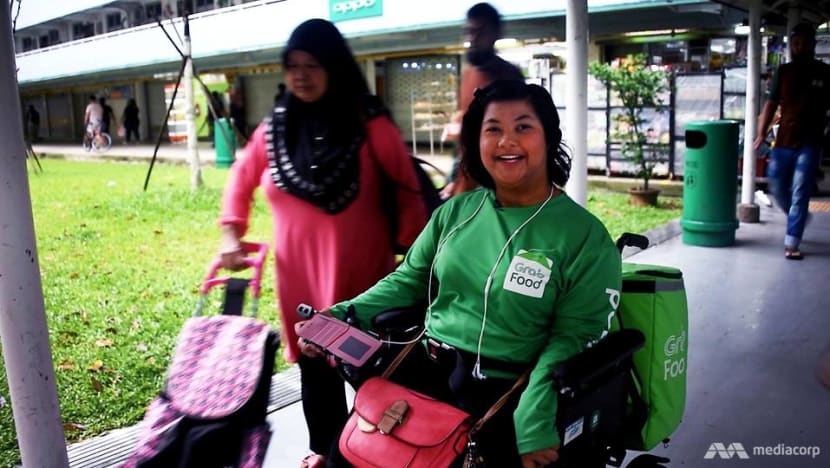Jobless for 7 years, woman with cerebral palsy finds hope, faces new hurdles
After getting rejected for jobs because she was ‘very slow’ or hard to understand, Roszana Ali had given up on finding work — until food delivery apps like GrabFood came along.
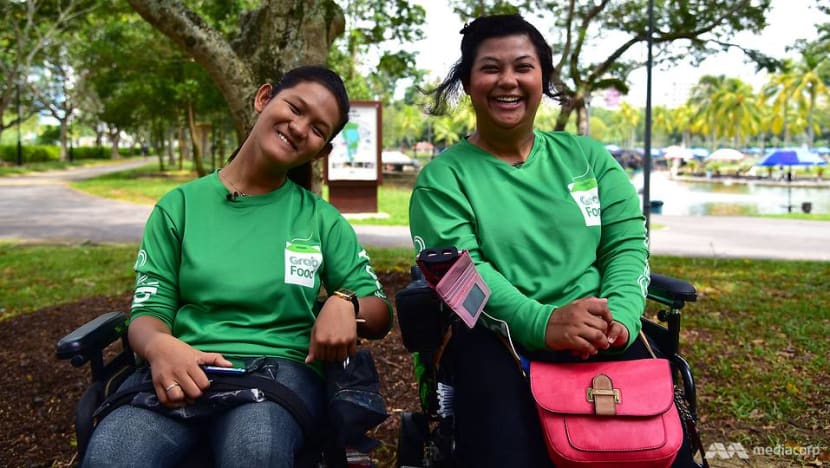
Ms Roszana Ali (right) has her best friend, Ms Juni Syafiqah Jumat, to thank for introducing her to her first job.
SINGAPORE: Like a superhero who is most powerful and visible when in costume, Ms Roszana Ali is a woman transformed when she wears her uniform. Without it, she feels invisible to people, or worse, that they look down on her.
With it, the 26-year-old feels a glow of pride. Her green outfit tells the rest of Singapore that she can work. On the day she collected it from GrabFood, she told herself, “Yes, at last.”
She had been waiting since she finished school seven years earlier — an intervening period in which earning money seemed out of reach to her. She had tried and failed to get a job until, bereft of confidence, she gave up.
Then came the work opportunity she secured without even having to say that she was in a wheelchair, or that she had cerebral palsy, a condition that affects muscle control and co-ordination.

Eight months and more than 600 deliveries later, she is enjoying her first real taste of independence as a GrabFood rider. It has given her and her family hope for the future.
But as with her life’s journey so far, it comes with a number of hurdles. These remain standing for lower-income people with disabilities even in the gig economy.
SHE STARTED SCHOOL AT 15
An estimated five per cent of people here with disabilities have jobs, which is one of the lowest rates among developed nations, The Straits Times reported recently.
Watch: Finding a job (and independence) with cerebral palsy (9:52)
And Ms Roszana is no stranger to having to wait for such milestones: She could not go to school until she was 15 years old.
Her cerebral palsy became apparent when she was aged two and started having seizures, “almost monthly”, recalled her father Ali Osman.
“When she was playing, she was normal. We gave her books; she tried to read and write. I trained her to write, but her hand was stiff, and until now, she finds it difficult,” said the 61-year-old.
“Whichever schools we wanted to put her into — mainstream schools — people would come, assess her condition and decide not to take her. They didn’t really help.”
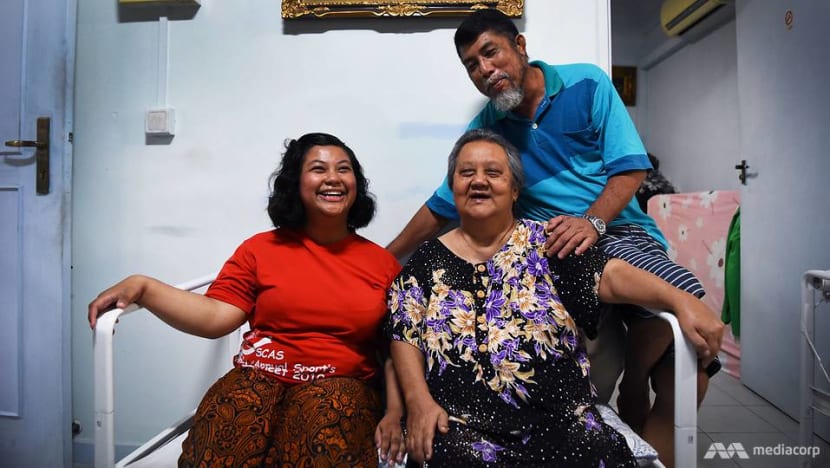
The young girl saw her two elder brothers going to school, and wanted the same. But her parents — a forklift driver and a kitchen helper at that time — could not afford or find a suitable special education school either.
“I felt sad. I kept asking my dad to apply to some for me, but (he) couldn’t get (any),” she recollected.
Still, she was determined to learn, and picked up English by listening to her brothers speak and watching Channel 5, helped sometimes by Malay subtitles.
Her seizures stopped when she was aged 12, and three years later, her father found a place for her in the Cerebral Palsy Alliance Singapore School in Pasir Ris.
“They also helped with transportation. The other schools couldn’t,” said Mr Ali, whose family lives in Jurong. “She was happy. She’d talk about school when she was back home … The teachers loved her and made her a monitor.”

While her teachers taught her functional skills, such as taking public transport and counting money, she also took more than 10 external courses, all in the hope of getting a job later.
For example, she received subsidised training in areas like basic internet skills, digital imaging and word processing, presentation and spreadsheet fundamentals at SPD’s Infocomm Accessibility Centre between 2009 and 2011. Some were extensions of what she was learning in school.
She also attained certificates in workplace literacy under the Workforce Skills Qualifications system. “They said if you take courses, it’ll be easier to find a job,” she noted.
After completing four years of school, however, she began to see that the odds were against her. She went for at least six job interviews and was rejected each time.

One, for example, was for a data entry job, “but they said … (I was) very slow”, she cited. “Obviously, (I was) sad.”
At the age of 22, she stopped looking and fell back on the cash assistance her family was receiving through the ComCare scheme.
‘I DID IT’
Last year, she finally gave herself a shot at another job, thanks to her best friend since school — the first person who talked to her when she was a shy new student.
Ms Juni Syafiqah Jumat, who also has cerebral palsy, had been working for GrabFood for three months when she encouraged Ms Roszana to do the same.

“Because I knew that it was very hard for people like us to find a job,” explained the 24-year-old. But her friend was reluctant, unsure if she was up to it.
Said Ms Roszana: “I said, ‘Cannot lah.’ Because I didn’t know how to go (about) on the roads … I didn’t go out much.”
Ms Syafiqah, however, would not take no for an answer and helped her to apply online. All that was needed was her name, address, date of birth and vehicle type, which she indicated was a personal mobility device. (Electric wheelchair was not given as an option, although change is coming. More on that later.)
On her first delivery, Ms Roszana needed her friend by her side because she was shy of people — since young — and afraid that her pronunciation “wasn’t so clear”. She added: “That’s why I was so scared.”
So Ms Syafiqah followed her to the customer’s block but waited at the void deck, resisting her friend’s appeal to accompany her up. Ms Roszana recalled with a laugh: “Sabo me.”
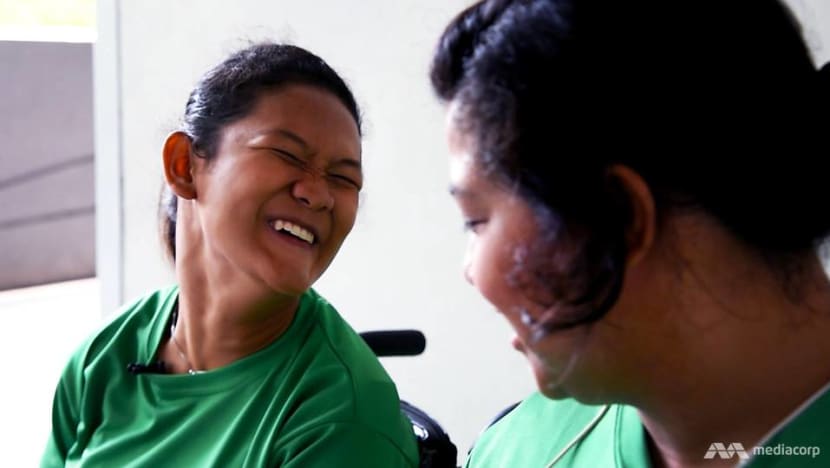
To add to her nerves, the customer had a dog, which made the rookie rider want to head straight back to her waiting friend. “Then I just relaxed … The person opened the door, then she said, ‘Oh, okay,’” she recounted.
The first thing she told her friend afterwards was “I did it”. Or as Ms Syafiqah put it, “She was so happy that she’d got that one order.”
Happiness turned into excitement by the time she made 20 deliveries — 80 more to go, and she would get her GrabFood uniform, which she did within a month.
She now works Tuesdays to Sundays, five hours a day, delivering food mostly from Jurong Point shopping centre.
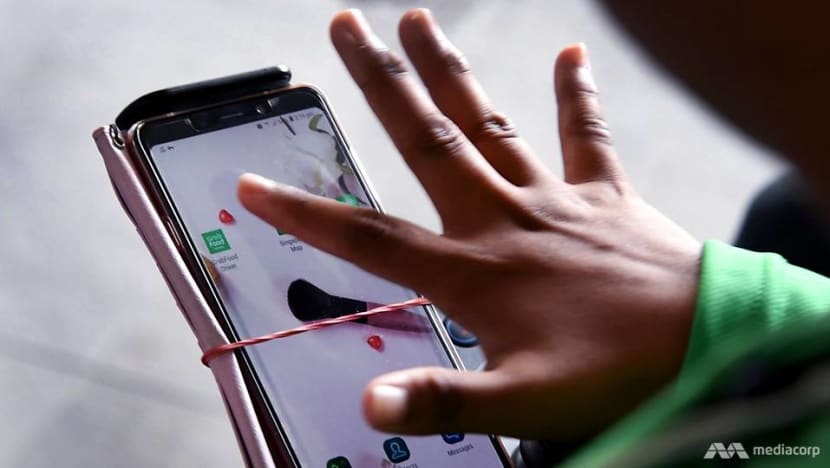
She typically makes between S$5 and S$7 per order, and is able to make five to seven deliveries a day before her electric wheelchair runs out of power.
The one mistake she has made was to spill a drink in her bag. But GrabFood covered the cost and communicated that to the customer.
She generally gets a good response from customers, who help her to take their food from her bag at the back of her wheelchair. Some “get a shock” to find a wheelchair user making the delivery.
“One ah ma even treated me. She was cooking bubur cha cha … She said, ‘Wow, you work. You wait, I’ll take for you some food,’” recounted Ms Roszana, who once even received S$60 from a passer-by.

DISABILITY CHALLENGES
While she has not encountered any nastiness so far, and attested that customers have not been angry at her if she is late, she does face challenges.
If the delivery distance is far, which to her is three to four kilometres, she is willing to go the extra mile by taking the MRT, even though a journey to and fro sets her back more than S$1.
As CNA Insider saw, distance can be compounded by other problems, like the time the lift at Pioneer MRT Station was not in operation. She was already running late and had to wait for the maintenance personnel to come.
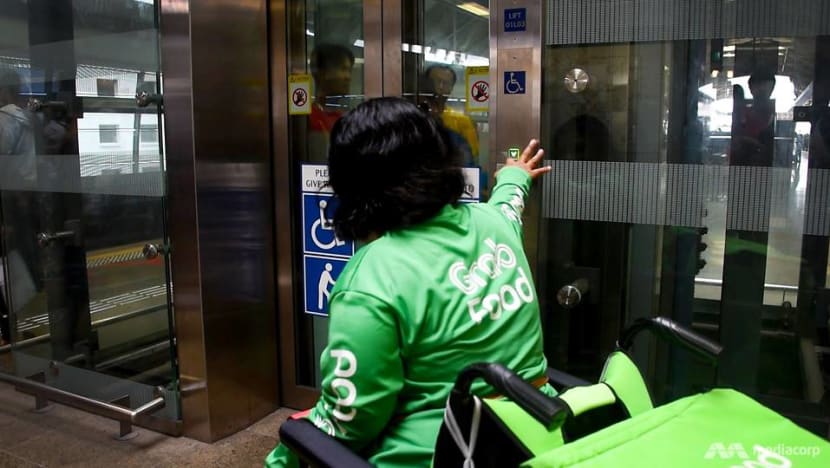
There was also an occasion when she went to Taman Jurong, only to realise the block did not have lift landings on all storeys.
“I said alamak … Luckily, I had a good customer (who came upstairs) to take the food,” she recounted.
Even so, home deliveries are more wheelchair accessible than office deliveries. She has to reject nearly nine in 10 orders owing to accessibility issues.
In the same amount of time that she makes her daily deliveries, a GrabFood rider on an e-scooter can earn about 2.5 times as much.
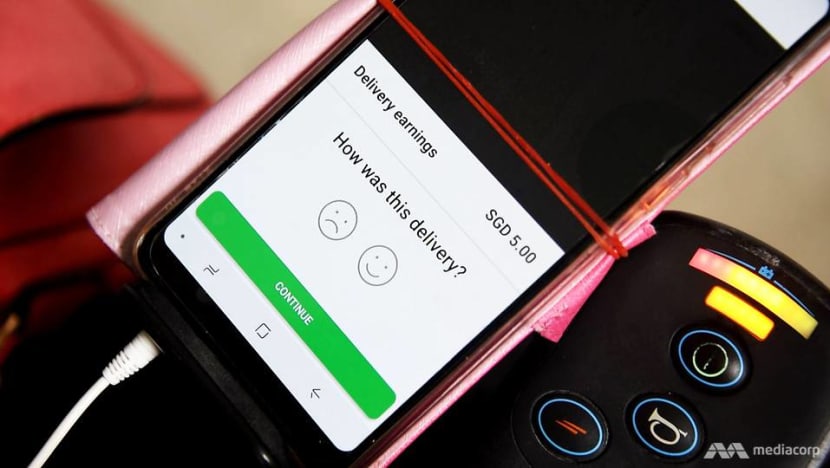
Despite having to navigate such obstacles, in the built environment or otherwise, “more people in Singapore, including those with disabilities, have been keen to take on jobs in the gig economy”, noted an SG Enable spokesperson.
“Such jobs offer people more flexibility in where and when they work, though they may be a less regular source of income,” she said.
The agency, which supports people with disabilities, works with training partners to offer courses in areas such as data analytics, website development, guestroom operations and food and beverage services.
More than 2,200 people with disabilities have taken part in such courses. And since SG Enable was set up in 2013, it has placed over 2,000 persons in jobs.
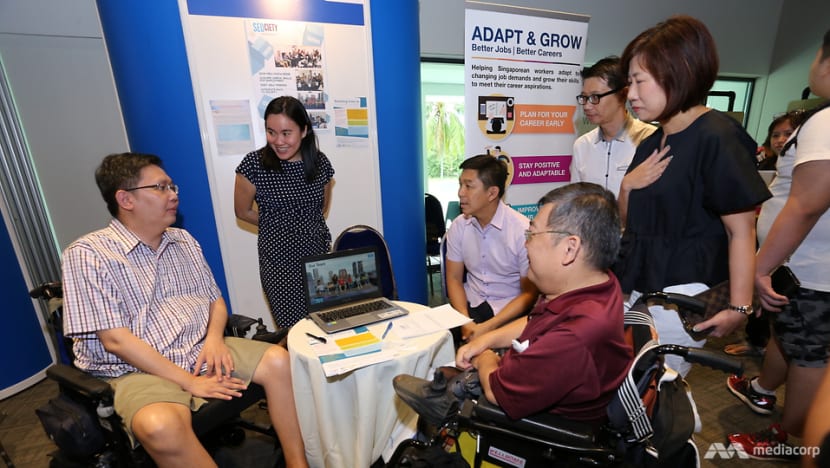
There are, however, 176,000 people with disabilities aged 20 to 64 (as of 2017) as reported by The Straits Times based on the authorities’ estimates of the prevalence of disability here.
And the government estimates that more than 8,600 people with disabilities were employed in the private and public sectors in 2017. More information will be collected in next year’s population census.
Meanwhile, to support students with disabilities who have the potential to work, there is a pilot School-to-Work Transition Programme, which has helped 120 students as of November. It will be rolled out to all special education schools by this year.
This is in addition to current schemes like the Open Door Programme, which offers employers subsidies and incentives to employ people with disabilities.

MAKING PLANS FOR THE FUTURE
Different groups of people with disabilities may be affected differently by unemployment. When it comes to cerebral palsy, Ms Syafiqah, who is a national boccia player, thinks that “even though you’re disabled, you can do things normal people can do”.
She and Ms Roszana are among 20 or so riders in wheelchairs out of the 13,000 on the GrabFood platform.
That was something the Grab team did not foresee, however, when the app was built, admitted GrabFood Singapore head Lim Kell Jay.
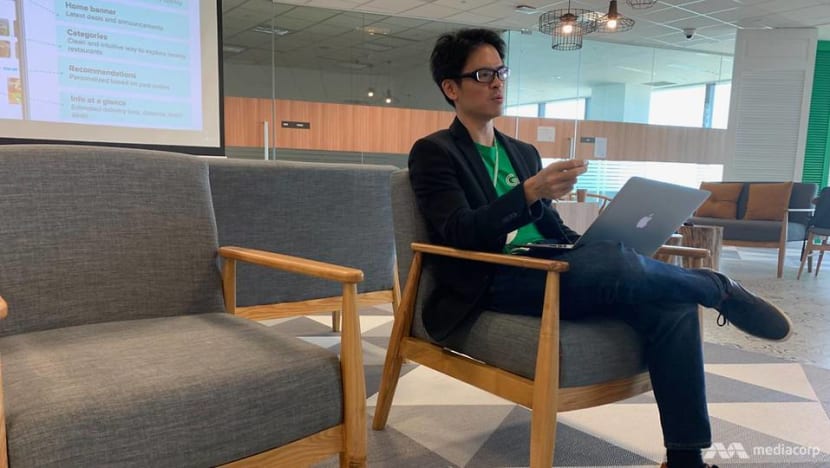
“I wish we could say that we developed this platform specifically to empower delivery partners with disabilities. The reality is they made it work for themselves,” he said,
“In the new app, we’ll add that (wheelchair as a vehicle option) … We do need to cater for them.”
For its part, the company does not give them deliveries beyond 3 to 4 km. It plans to exclude areas that are not wheelchair-friendly, so that this group will not have to waste time rejecting orders.
“We gather feedback from them as well. It's an ongoing process of labelling (the) areas,” explained Mr Lim, who is also Grab’s co-chief of staff to the CEO. “Once we build up this database, we’ll be able to be accurate.”
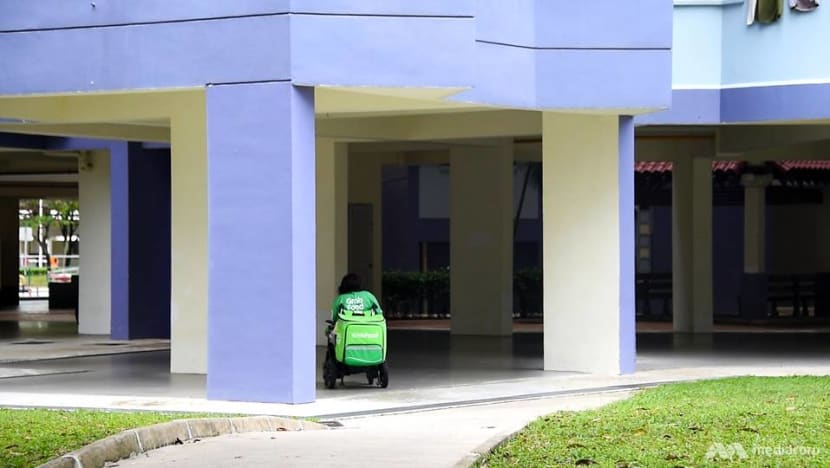
Mr Ali, who is all for a smaller delivery radius, still worries about his daughter’s safety when she is on the move, especially in bad weather. But he is also thankful that she has got a job.
“I want to see Roszana healthy, and … whatever I wanted to see achieved has already been realised, now that she’s already smart (and independent),” he said. “She can now succeed, and … with her help, we get to eat.”
The family now receives S$850 through ComCare, as well as help with their utilities bill and service and conservancy charges.
But with Mr Ali and his wife unable to work because of health issues, he thinks they would have been in a “jam” if not for their daughter.
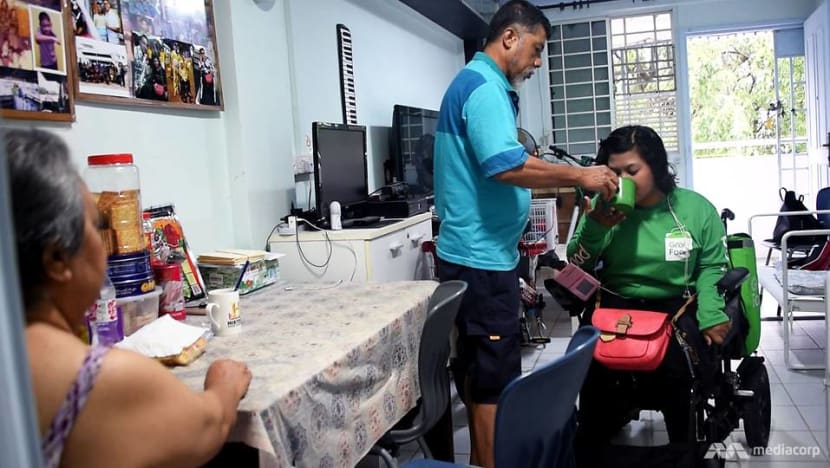
The job has also been beneficial to her in other ways. “Last time, I felt sad, very bored,” she said. “(Now) I’m very happy. It has changed me a lot. I can find money, help (my) parents.”
She has also found self-confidence and contentment, even if the kinds of benefits and stability that usually come with full-time employment are lacking. Her father, however, wants even more for her in future.
“If we have money from (withdrawing our) CPF savings, I’d like to open an eatery for her. Let her manage it,” he said.
Ms Roszana has a different dream. “I want to be a model,” she said with a smile. “I like dressing up … I just like fashion.”
